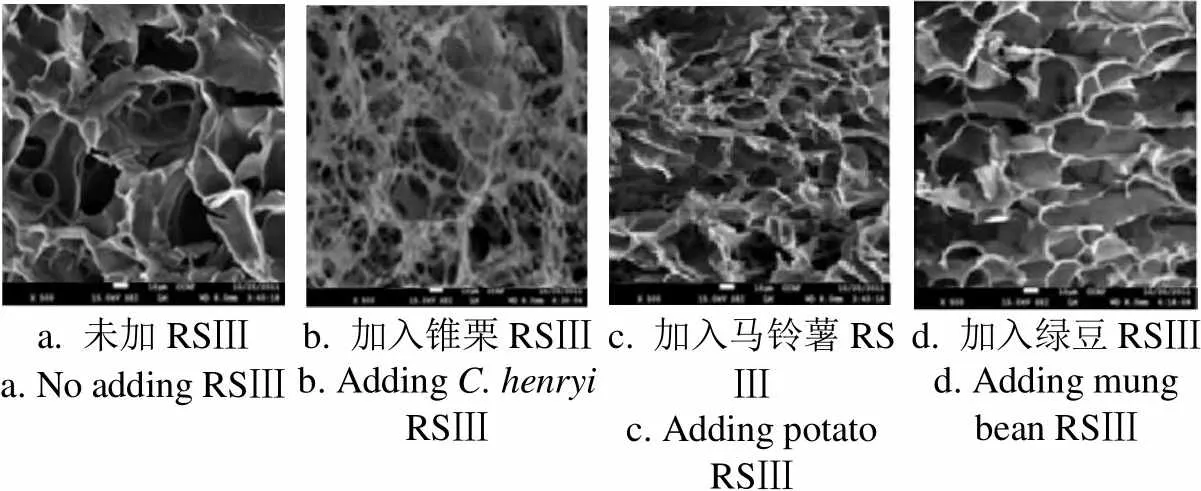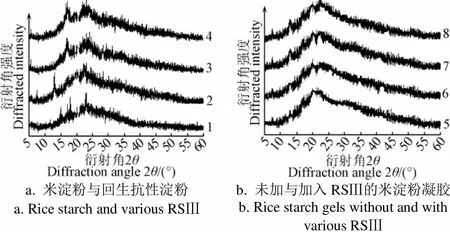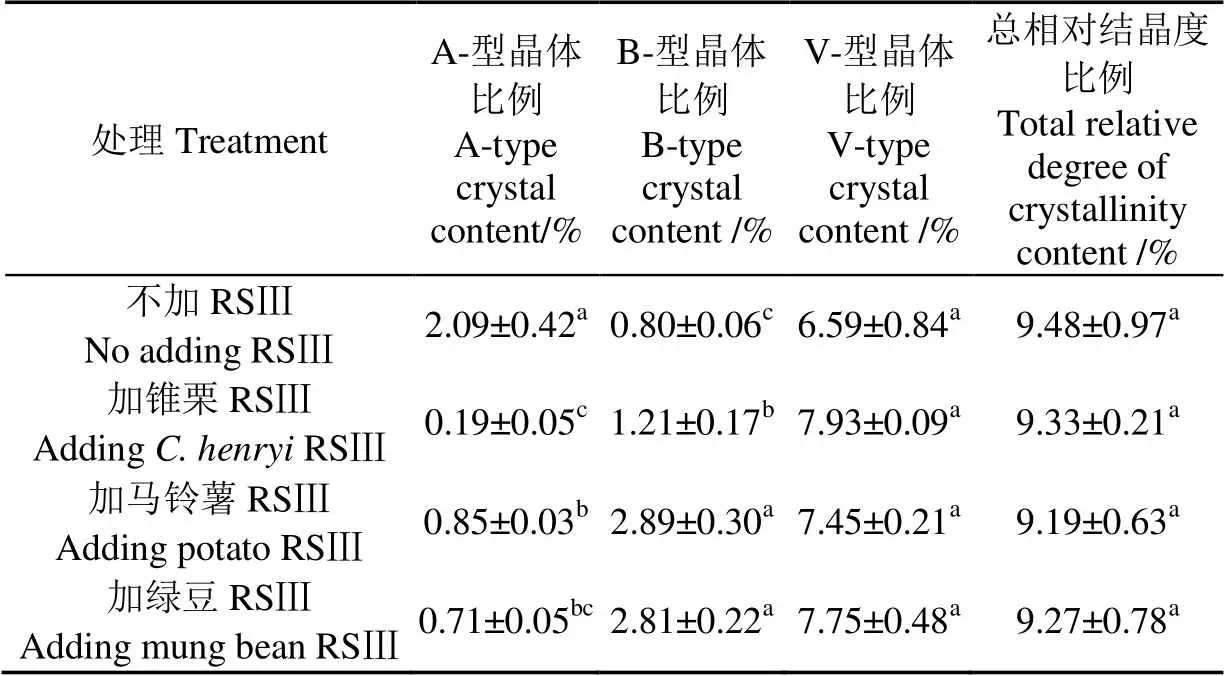回生抗性淀粉种类对米淀粉凝胶形成的影响
2017-03-27易翠平刘小龙
谢 涛,李 英,易翠平,刘小龙
回生抗性淀粉种类对米淀粉凝胶形成的影响
谢 涛1,李 英2,易翠平3,刘小龙1
(1. 湖南工程学院化学化工学院,湘潭 411104; 2. 湖南工程学院图书馆,湘潭 411104; 3. 长沙理工大学化学与生物工程学院,长沙 410015)
为寻找改善普通米淀粉制品的结构及品质的新型食品添加剂,该文以普通米淀粉为原料,采用快速黏度分析仪、扫描电子显微镜、质构分析仪、全自动X射线衍射仪及示差扫描量热仪等手段,研究添加锥栗、马铃薯与绿豆回生抗性淀粉(retrograded resistant starch,RSⅢ)对米淀粉凝胶微观结构及理化性质的影响。结果表明:添加锥栗、马铃薯及绿豆RSⅢ对米淀粉凝胶的结构及性质产生显著影响(<0.01),以锥栗RSⅢ的作用最为突出。添加锥栗、马铃薯与绿豆RSⅢ对米淀粉糊的黏度特性没有影响(>0.05)。未添加RSⅢ的米淀粉凝胶存在很多不规则、深浅不一的大洞,而加入RSⅢ使米淀粉凝胶的网状结构变得更为规整、致密,且其胶着性与黏聚性变化不大(>0.05);添加锥栗、马铃薯与绿豆RSⅢ后能加速米淀粉凝胶的形成,与未添加RSⅢ的米淀粉凝胶比,其硬度分别增加了2.38、1.97和1.25倍(<0.01),黏着性分别增加2.56、1.99和1.32倍(<0.01),弹性增加1.07、0.81和0.53倍(<0.01)。米淀粉以A-型晶体占优,锥栗RSⅢ以V-型晶体占优,马铃薯与绿豆RSⅢ均以B-型晶体占优;不加或加入RSⅢ的米淀粉凝胶粉末都转变为以V-型晶体为主,且总相对结晶度没有改变(>0.05)。加入RSⅢ后的米淀粉糊除有低温吸热峰外还出现高温吸热峰,是否添加RSⅢ对低温吸热峰的温度参数影响不大(>0.05),但吸热焓显著降低(<0.01);而对于高温吸热峰,添加马铃薯与绿豆RSⅢ的各项参数没有差别(>0.05),但比添加锥栗RSⅢ的显著增高(<0.01)。可见添加不同来源的RSⅢ可以有效改善米淀粉凝胶的结构与品质。该研究结果为抗性淀粉用于提高米制品品质与营养功能的研究和生产提供了重要参考。
淀粉;凝胶;物理性质;化学性质;回生抗性淀粉;米淀粉
0 引 言
淀粉糊化是指当淀粉颗粒在过量水中被加热到糊化温度以上时,颗粒吸水膨胀导致晶体有序结构崩塌,而颗粒中的直链淀粉沥滤出来,并随着淀粉糊液的冷却而形成三维凝胶网状结构[1]。淀粉凝胶在老化或回生过程中会产生结构变化,包括直链与支链淀粉的重结晶[2]。淀粉起始糊化阶段以可溶性直链淀粉的糊化为主,淀粉颗粒的结构变化引起淀粉糊和凝胶的流变特性改变,溶胀的淀粉颗粒一旦冷却则形成具有高剪切强度的紧密堆积的凝胶结构[3]。淀粉凝胶结构与淀粉来源及浓度、溶胀淀粉结构、从淀粉颗粒中沥滤出来的直链和支链淀粉数量、外源亲水聚合物和加热条件等因素有关[4-6]。
抗性淀粉(resistant starch,RS)分为物理包埋淀粉(physically trapped starch,RSⅠ)、天然抗性淀粉颗粒(resistant starch granules,RSⅡ)、回生或老化抗性淀粉(retrograded resistant starch,RSⅢ)和化学改性淀粉(chemically modified starch,RSⅣ)4个类型[7-9]。RS在小肠内不能消化但通过大肠益生菌发酵产生短链脂肪酸,可预防肠道疾病[10]。当RS添加入淀粉基食品中,其结构可能发生改变,如B-型的RSⅡ在过量水存在下因加热而产生糊化,但RSⅢ、RSⅣ在正常烹饪条件下因其高热稳定性可能维持原有结构[11-13]。淀粉-RS混合形成的凝胶特性受淀粉来源、淀粉与水的比例、RS类型及其含量等的影响[13-15]。例如,普通米淀粉正常情况下因其直链淀粉含量低(12%~20%,质量分数)而不能形成黏弹性凝胶,若添加某些亲水性多糖(如RS)能改善米淀粉凝胶的结构[14-17]。在国外,已有RS应用于米粉制品中的研究,发现添加RS不仅能提高年糕、米饼、米粉等传统米制食品的膳食纤维含量,更能改善它们的品质与营养价值,但其改善品质的机理尚不十分清楚[11-14]。然而,国内尚罕见这方面的研究报道。
为了克服普通米淀粉在正常情况下不能形成黏弹性凝胶,且在硬度、弹性和黏着性等方面存在的缺陷。本文研究了制备自锥栗、马铃薯和绿豆的RSⅢ为代表的非米淀粉来源RSⅢ的添加对米淀粉凝胶的形成及其品质的影响,从而为添加RS提高米制品品质与营养功能的深加工提供科学依据与实践基础。
1 材料与方法
1.1 材 料
米淀粉由购自超市的籼米实验室自制,其水分、粗蛋白、灰分、粗脂肪与直链淀粉质量分数分别为12.56%、0.25%、0.41%、0.06%和24.63%。锥栗淀粉由实验室自制,食用级马铃薯、绿豆淀粉购自四川友嘉食品有限公司,糖化酶(50 000 U/g)、高温-淀粉酶(20 000 U/g)由无锡杰能科生物工程有限公司生产,其他试剂均为分析纯。
1.2 RSⅢ的制备
参照文献[18-19]的方法。用蒸馏水配制质量分数为30%的淀粉乳液,调节pH值为6.0,沸水浴30 min后,121 ℃高温高压处理40 min。冷却,4 ℃放置24 h,80 ℃烘干,粉碎过100目筛得粗抗性淀粉。取粗抗性淀粉用耐热-淀粉酶在70 ℃水解1 h,加入过量糖化酶,55 ℃水解2 h,离心(3 000r/min,30 min),水洗离心多次,最后用95%乙醇清洗,干燥,粉碎,过200目筛,得纯RSⅢ。经碘吸收法测得锥栗、马铃薯与绿豆RSⅢ的平均聚合度分别为48、61和72。
1.3 米淀粉凝胶的制备
由于12%(质量分数)的米淀粉不能形成正常凝胶,因此选用这个浓度研究回生抗性淀粉对米淀粉凝胶形成的影响。用去离子水配制12%(质量分数,干基)的米淀粉浆,根据前期试验结果分别加入10%(质量分数,淀粉基)的不同种类的回生抗性淀粉,密封于压热瓶中,于沸水浴中处理30 min。淀粉糊被灌入小段不锈钢柱,注意糊中不能含有气泡,且在上盖玻璃板。淀粉凝胶在25 ℃放置6 h,然后小心移出即为样品,用于测定其各项理化特性。
1.4 测定方法
黏度特性:采用RVA-4型快速黏度分析仪(澳大利亚Warriewood公司)。采用3 g含10%(质量分数,淀粉基)RSⅢ的米淀粉与25 mL去离子水在一个小铝罐内混合均匀。每个样品悬浮液在50 ℃保持1 min,以12 ℃/min快速加热至95 ℃并维持2.5 min,再以12 ℃/min降温至50 ℃。
超微结构:将液氮真空干燥法制得的干燥样品用导电胶粘在样品座上,并置于离子溅射仪中,在样品表面蒸镀一层铂金膜后,再在S-3400N型扫描电子显微镜(日本日立公司)下进行观察与拍照。
质构特性:采用TA-XT Plus质构分析仪(英国Surrey公司)。设定发生50%的形变,形变速率1.5 mm/s。
结晶特性:采用连续扫描法,D/max2500全自动X射线衍射仪(日本理学株式会社)测定条件:扫描速率12°/min,扫描范围5°~60°,步长0.04,管压40 kV,管流30 mA。
热特性:称取一定量含10%(质量分数,淀粉基)RSⅢ的米淀粉,按质量比1:2加入重蒸水,密封后置于4 ℃冰箱中隔夜平衡,再称取5.0 mg左右(精确到0.1 mg)于铝坩埚中,压片。用DSC200型示差扫描量热仪(德国NETZSCH公司)测定:扫描温度范围为20~180 ℃,扫描速率为10 ℃/min,以空坩埚为参比,载气氮流速20 mL/min。
所有数据为3个平行试验的平均值,且采用SPSS 20.0的Duncan’s multiple range test法进行多组样本间差异显著性分析。
2 结果与分析
2.1 RSⅢ对米淀粉糊黏度特性的影响
加入10%(质量分数,淀粉基)的RSⅢ对米淀粉黏度特性的影响如表1所示。由表1可知,分别加入锥栗、马铃薯与绿豆RSⅢ对米淀粉糊的起始糊化温度、峰值黏度、低谷黏度、冷却黏度、崩解值与回生值的影响不大(>0.05),这是因为RSⅢ是由直链淀粉在重结晶或回生过程中通过分子重排与重组形成的,而直链淀粉分子在加热的淀粉糊中处于溶解状态,因此RSⅢ对米淀粉糊的黏度特性没有明显影响。

表1 不加或加入RSⅢ的米淀粉糊的黏度特性
注:表中不同字母表示存在显著差别(<0.01),相同字母则表示差别不显著(>0.05),下同。
Note: Different letters in table mean significant difference (<0.01), while the same letter indicates no significant difference (>0.05), The following tables are all the same.
2.2 RSⅢ对米淀粉凝胶超微结构的影响
据文献[4-6]报道,淀粉凝胶的形成及其强度受到淀粉来源、直链淀粉含量、淀粉浓度、分子结构、改性方法、添加其他物质、受热程度等因素的影响。另据Kim等[14]报道,高直链米淀粉在12%(质量分数,干基)时能形成正常的凝胶,而普通米淀粉则不能,这是由于普通米淀粉除颗粒很小(2~8m)之外,特别是可溶性直链淀粉含量低;而亲水性线性物质如可溶性葡萄糖链、亲水胶体的添加能改善凝胶的结构与质地。作者的前期研究[20]也发现,压热法制备的锥栗、马铃薯与绿豆RSⅢ具有不规则的由双螺旋直链淀粉形成的、致密牢固的片层结构,存在无定形区域和结晶区域,热稳定性好,对淀粉水解酶类有抗性;而且,RSⅢ的无定形部分保持较高的持水能力,容易被溶解。添加或未添加RSⅢ的米淀粉凝胶结构如图1所示,未添加RSⅢ的米淀粉凝胶存在很多不规则的、深浅不一的大洞(图1a),而添加了RSⅢ的米淀粉凝胶结构都有不同程度的改善,变得更为规整、致密(图1b~1d),可能归因于添加RSⅢ增加了凝胶体系中亲水性直链淀粉的数量,与体系中线性聚合物链的相互作用变得更强,有利于形成更牢固可靠的凝胶网络结构。

a. 未加RSⅢa. No adding RSⅢb. 加入锥栗RSⅢb. Adding C. henryi RSⅢc. 加入马铃薯RSⅢc. Adding potato RSⅢd. 加入绿豆RSⅢd. Adding mung bean RSⅢ
由图1b~1d还可看出,加入锥栗、马铃薯与绿豆RSⅢ后,米淀粉凝胶网状结构由疏松不规整逐渐变得均匀致密。这是因为锥栗、马铃薯与绿豆RSⅢ的平均聚合度分别为48、61和72,相同质量条件下它们所含的直链淀粉数量依次减少,因此由直链淀粉数量递减而发生的亲水作用逐渐减弱[20]。综上所述,添加锥栗、马铃薯与绿豆RSⅢ有助于低浓度普通米淀粉形成三维凝胶网状结构。
2.3 RSⅢ对米淀粉凝胶质构特性的影响
是否加入10%(质量分数,淀粉基)的RSⅢ对12%(质量分数,干基)米淀粉凝胶质构特性的影响见表2。由表2可看出,添加RSⅢ对米淀粉凝胶的胶着性与黏聚性影响不大(>0.05),而对硬度、弹性与黏着性的影响显著(<0.01)。与未添加RSⅢ的对照比,添加锥栗、马铃薯与绿豆RSⅢ后能够加速米淀粉凝胶的形成,使其硬度分别增加了2.38、1.97和1.25倍,黏着性分别增加了2.56、1.99和1.32倍,弹性也增加了1.07、0.81和0.53倍,但增加倍数随添加RSⅢ的平均聚合度增加而逐渐降低,说明更高的可溶性亲水直链淀粉含量更有利于改善米淀粉凝胶的结构与质地。因此,在米粉、年糕、米饼等米制品中加入RSⅢ是十分必要的,它们可以弥补普通米淀粉凝胶在硬度、弹性和黏着性方面存在的不足,从而提高普通米制品的品质与营养功能价值[11-14]。
2.4 RSⅢ对米淀粉凝胶结晶特性的影响
X-射线衍射峰的强度及半峰宽的变化反映了颗粒结晶度的大小、无定形化程度和晶格畸变等情况,且根据X射线衍射图谱,将淀粉分为A-、B-和V-几种类型:A型在衍射角15°、17°、18°和23°有较强的衍射峰,B型在衍射角5.6°、17°、22°和24°有较强的衍射峰,V型在衍射角7.4°、13°和20°有较强的衍射峰[21-24]。淀粉主要是由A-型、B-型与V-型晶体组成的混合物,各型晶体所占的比例不同[22,25]。图2是普通米淀粉、RSⅢ及不加或加RSⅢ米淀粉凝胶粉末的X-衍射图谱。普通米淀粉以A-型晶体占优势,锥栗RSⅢ以V-型晶体占优势,马铃薯与绿豆RSⅢ均以B-型晶体占优势(图2a);但是,不加或加入RSⅢ的米淀粉凝胶粉末都转变为以V-型晶体为主(图2b),且加入RSⅢ与未加RSⅢ的米淀粉凝胶粉末的总相对结晶度基本没有发生变化(表3),这表明在低温下米淀粉凝胶的形成过程实际上就是在稀淀粉分散液中主要由无定形聚合物链形成三维网络结构的过程,在稀淀粉糊中线性淀粉分子不能像重结晶或回生的直链淀粉一样形成稳定的双螺旋结构[14]。

表2 不加或加入RSⅢ的米淀粉凝胶的质构特性

a. 米淀粉与回生抗性淀粉a. Rice starch and various RSⅢb. 未加与加入RSⅢ的米淀粉凝胶b. Rice starch gels without and with various RSⅢ
1.米淀粉 2.锥栗RSⅢ 3.马铃薯RSⅢ 4.绿豆RSⅢ 5.未加RSⅢ的米淀粉凝胶 6.添加锥栗RSⅢ的米淀粉凝胶 7.添加马铃薯RSⅢ的米淀粉凝胶 8.添加绿豆RSⅢ的米淀粉凝胶
1.Rice starch 2.RSⅢ 3.Potato RSⅢ 4.Mung bean RSⅢ 5.Rice starch gel no adding RSⅢ 6.Rice starch gel addingRSⅢ 7.Rice starch gel adding potato RSⅢ 8.Rice starch gel adding mung bean RSⅢ
图2 米淀粉、RSⅢ及不加或加入RSⅢ米淀粉凝胶粉末的X-射线衍射图谱
Fig.2 X-ray diffractograms of native rice starch, RSⅢ and rice starch gel powder without or with RSⅢ

表3 几种RSⅢ及其加入米淀粉形成的凝胶粉末的晶型及相对结晶度
2.5 RSⅢ对米淀粉糊热特性的影响
文献[20]已报道,绿豆与马铃薯RSⅢ的起始糊化温度(T)、峰值糊化温度(T)、终止糊化温度(T)均要高于锥栗RSⅢ的T、T、T值,但3种RSⅢ的吸热焓()差别不大,可能是绿豆与马铃薯抗性淀粉中A型晶体仍然占有较大比例的缘故(表3);而且,文献[20]还报道了这3种RSⅢ的T、T、T、值分别比其原淀粉的T、T、T、值要高得多,这是因为RSⅢ在制备过程中直链淀粉形成更为致密的结晶结构,导致破坏该晶体结构需要的温度更高[26-28]。在12%(质量分数,干基)米淀粉中加入10%(质量分数,淀粉基)的RSⅢ对其热特性的影响见表4。

表4 不加或加入RSⅢ的米淀粉糊的差示扫描量热分析参数
注:T为起始糊化温度,T为峰值糊化温度、T为终止糊化温度、T - T为糊化温差,为糊化焓,∑为总糊化焓。
Note:Tis initial gelatinization temperature,Tis peak gelatinization temperature,Tis conclusive gelatinization temperature,T - Tis gelatinization temperature difference,is gelatinization enthalpy, and ∑is total gelatinization enthalpy.
由表4可知,不加RSⅢ的米淀粉糊只有低温吸热峰出现,但加入RSⅢ后还出现了高温吸热峰,说明它是由RSⅢ加入引起的,因为RSⅢ的结构较之米淀粉颗粒更为致密、牢固。对于低温吸热峰,是否添加RSⅢ对其T、T与T值的影响不大(>0.05),而引起却显著降低(<0.01)。对于高温吸热峰,添加马铃薯与绿豆RSⅢ的差别不明显(>0.05),但各个参数比添加锥栗RSⅢ的显著增高(<0.01),这可能是因为通常情况下B-型晶体比V-型晶体要更稳定些[29-30],而马铃薯与绿豆RSⅢ中以B-型晶体比例较高,锥栗RSⅢ以B-型晶体比例较小,且其相对结晶度比前两者要低。尽管添加RSⅢ导致低温吸热焓降低,但两个吸热峰的总吸热焓却明显增大(<0.01)。
3 结 论
尽管制备方法相同,但由于原淀粉的组成、结构与性质的差别,相应地回生抗性淀粉(retrograded resistant starch,RSⅢ)的组成、结构与性质也不同。在米淀粉凝胶中加入RSⅢ,无疑能够增加其膳食纤维含量,更能改善其结构与性质,而且这种改变的大小与RSⅢ的来源有关。
1)加入10%(质量分数,淀粉基)的锥栗、马铃薯与绿豆RSⅢ对米淀粉糊的起始糊化温度、峰值黏度、低谷黏度、冷却黏度、崩解值与回生值基本无影响(>0.05)。
2)未添加RSⅢ的米淀粉凝胶存在很多不规则的、深浅不一的大洞,而加入RSⅢ后低浓度普通米淀粉凝胶网状结构变得更为规整、致密,以锥栗RSⅢ的作用最好、马铃薯RSⅢ居中。
3)添加RSⅢ对米淀粉凝胶的胶着性与黏聚性影响不大(>0.05),而对硬度、弹性与黏着性的影响显著(<0.01)。与未添加RSⅢ的相比,添加锥栗、马铃薯与绿豆RSⅢ后形成的米淀粉凝胶的硬度分别增加了2.38、1.97和1.25倍,黏着性分别增加了2.56、1.99和1.32倍,弹性也增加了1.07、0.81和0.53倍,且增加倍数以锥栗RSⅢ的最显著。
4)普通米淀粉以A-型晶体占优,锥栗RSⅢ以V-型晶体占优,马铃薯与绿豆RSⅢ均以B-型晶体占优;不加或加入RSⅢ的米淀粉凝胶粉末都以V-型晶体为主,且总相对结晶度基本没有改变(>0.05)。
5)不加RSⅢ的米淀粉糊只有低温吸热峰,加入RSⅢ后还出现高温吸热峰。是否添加RSⅢ对低温吸热峰的起始糊化温度、峰值糊化温度与终止糊化温度影响不大(>0.05),但总糊化焓显著降低(<0.01)。对于高温吸热峰,添加马铃薯与绿豆RSⅢ的几无差别(>0.05),但起始糊化温度、峰值糊化温度与终止糊化温度与总糊化焓值比添加锥栗RSⅢ的显著增高(<0.01)。
[1] Tester R F, Karkalas J, Qi X. Review starch composition, fine structure, and architecture [J]. J Cereal Sci, 2004, 39: 151-165.
[2] Lee H J, Shin M. Comparison of the properties of wheat flours supplemented with various dietary fibers[J]. Food Sci Biotechnol, 2006, 15: 746-751.
[3] Lu Z H, Sasaki T, Li Y Y, et al. Effect of amylose content and rice type on dynamic viscoelasticity of a composite rice starch gel[J]. Food Hydrocolloid, 2009, 23(5): 1712-1719.
[4] Kim J O, Kim W S, Shin M S. A comparative study on retrogradation of rice starch gels by DSC, X-ray diffraction and α-amylase [J]. Starch-Stärke, 1997, 49(1): 71-75.
[5] Liu Q, Thompson DB. Effects of moisture content and different gelatinization heating temperatures on retrogradatiion of waxy type maize starches[J]. Carbohyd Res, 1998, 314(1): 221-235.
[6] Sodhi N S, Sasaki T, Lu Z H, et al. Phenomenological viscoelasticity of some rice starch gels[J]. Food Hydrocolloid, 2010, 24(2): 512-517.
[7] Shu X, Jia L, Gao J, et al. The influences of chain length of amylopectin on resistant starch in rice (L.)[J]. Starch-Stärke, 2007, 59(2): 504-509.
[8] Fässler C, Arrigoni E, Venema K, et al. In vitro fermentability of differently digested resistant starch preparations[J]. Mol Nutr Food Res, 2006, 50(4): 1220-1228.
[9] Zhang H, Jin Z. Preparation of products rich in resistant starch from maize starch by an enzymatic method[J]. Carbohyd Polym, 2011, 86: 1610-1614.
[10] Fuentes-Zaragoza E, Riquelme-Navarrete MJ, Sánchez-Zapata E, et al. Resistant starch as functional ingredient: A review[J]. Food Res Int, 2010, 43(3): 931-942.
[11] Ren C, Shin M. Effects of cross-linked resistant rice starch on the quality of Korean traditional rice cake[J]. Food Sci Biotechnol, 2013, 22(2): 697-704.
[12] Pongjanta J, Utaipattanaceep A, Naivikul O, et al. Debranching enzyme concentration effected on physicochemical properties and-amylase hydrolysis rate of resistant starch type III from amylose rice starch [J]. Carbohyd Polym, 2009, 78(1): 5-9.
[13] Ozturk S, Koksel H. Production of resistant starch from acid-modified amylotype starches with enhanced functional properties[J]. J Food Eng, 2011, 103(1): 156-164.
[14] Kim JG, Zhang C, Shin MS. Forming rice starch gels by adding retrograded and cross-linked resistant starch prepared from rice starch[J]. Food Sci Biotechnol, 2015, 24(3): 835-841.
[15] Mun SH, Shin M. Mild hydrolysis of resistant starch from maize[J]. Food Chem, 2006, 96(1): 115-121.
[16] Huang M, Kennedy JF, Li B, et al. Characters of rice starch gel modified by gellan, carrageenan, and glucomannan: A texture profile analysis study[J]. Carbohyd Polym, 2007, 69(2): 411-418.
[17] Song J Y, Park J H, Shin M. The effects of annealing and acid hydrolysis on resistant starch level and the properties of cross-linked RS4 rice starch[J]. Starch-Stärke, 2011, 63(1): 147-153.
[18] 曾红华,谢涛,杨莉,等. 几种薯类与豆类抗性淀粉的的抗消化性及其益生效应[J]. 中国粮油学报,2012,27(11):30-34.
Zeng Honghua, Xie Tao, Yang Li, et al. Anti-digestibility of several tubers and legumes resistant starches and their proliferation of probiotics [J]. Journal of the Chinese Cereals and Oils Association, 2012, 27(11): 30-34. (in Chinese with English abstract)
[19] 谢涛,张淑远,王美桂,等. 重结晶红薯淀粉体外消化前后益生作用与结构变化[J]. 农业机械学报,2013,44(8):203-208.
Xie Tao, Zhang Shuruan, Wang Meigui, et al. Probiotic functions and structure changes of recrystallised sweet potato starches before and after in vitro digestion[J]. Transactions of the Chinese Society for Agricultural Machinery, 2013, 44(8): 203-208. (in Chinese with English abstract)
[20] 谢涛,曾红华,汪婕,等. 4种抗性淀粉的主要理化特性[J]. 中国粮油学报,2014,29(9):78-84.
Xie Tao, Zeng Honghua, Wang Jie, et al. Main physicochemical properties of 4 resistant starches[J]. Journal of the Chinese Cereals and Oils Association, 2014, 29(9): 78-84. (in Chinese with English abstract)
[21] Cairns P, Sun L, Morris VJ. Physicochemical studies using amylase as an in-vitro model for resistant starch[J]. Journal of Cereal Science, 1995, 21(1): 37-47.
[22] Lopez-Rubio A, Flanagan BM, Gilbert E P. Molecular rearrangement of starch during in vitro digestion: toward a better understanding of enzyme resistant starch formation in processed starches[J]. Biomacromolecules, 2008, 9(7): 1951-1958.
[23] Bian Linlin, Chung H J. Molecular structure and physicochemical properties of starch isolated from hydrothermally treated brown rice flour[J]. Food Hydrocolloids, 2016, 60: 345-352.
[24] 刘贵萧,牛凯,侯汉学,等. 均质压力对玉米淀粉机械力化学效应的影响[J]. 农业工程学报,2017,33(1):271-278.Liu Guixiao, Niu Kai, Hou Hanxue, et al. Effect of homogenizing pressure on mechanochmical properties of corn starch [J]. Transactions of the Chinese Society for Agricultural Engineering (Tramsactions of TCSAE), 2017, 33(1): 271-278. (in Chinese with English abstract)
[25] Ren C, Shin M. Effects of cross-linked resistant rice starch on the quality of Korean traditional rice cake[J]. Food Sci Biotechnol, 2013, 22: 697-704.
[26] Li S L, Ward R, Gao Q Y. Effect of heat-moisture treatment on the formation and physicochemical properties of resistant starch from mung bean () starch[J]. Food Hydrocolloids, 2011, 25(6): 1702-1709.
[27] Mutungi C, Rost E, Onyango C, et al. Crystallinity, thermal and morphological characteristics of resistant starch type Ⅲproduced by hydrothermal treatment of debranched cassava starch[J]. Starch-Starke, 2009, 61(11): 634-645.
[28] 张斌,罗发兴,黄强,等. 不同直链含量玉米淀粉结晶 结构及其消化性研究[J]. 食品与发酵工业,2010(8):26-30.
Zhang Bin, Luo Faxing, Huang Qiang, et al. Crystallinestructures and digestibility of corn starches with different amylose/amylopectin content[J]. Food and Fermentation Industries, 2010(8): 26-30. (in Chinese with English abstract)
[29] Mutungi C, Rost E, Onyango C, et al. Crystallinity, thermal and morphological characteristics of resistant starch type Ⅲ produced by hydrothermal treatment of debranched cassava starch[J]. Starch-Starke, 2009, 61 (11): 634-645.
[30] Mutungi C, Onyango C, Rost F, et al. Structural and physicochemical properties and in vitro digestibility of recrystallized linear-D-(1→4) glucans derived from mild-acid modified cassava starch[J]. Food Research International, 2010, 43(4): 1144-1154.
Effect of retrograded resistant starch types on forming rice starch gel
Xie Tao1, Li Ying2, Yi Cuiping3, Liu Xiaolong1
(1.411104,; 2.411104,; 3.410015,)
In order to improve the structure and qualities of general rice starch products, effects of retrograded resistant starches (RSⅢ) made from(), potato and mung bean on microstructure and physicochemical properties of rice starch gels were investigated by using modern analysis methods, including RVA-4 rapid viscosity analyzer, S-3400N scanning electron microscope, TA-XT Plus structure analyzer, D/max2500 automatic X-ray diffractometer and DSC200 differential scanning calorimeter. The results demonstrated that the structure and properties of rice starch gel had a significant change (<0.01)after adding, potato and mung bean RSⅢ, respectively. Especially the role ofRSⅢ was the most prominent. The, potato and mung bean RSⅢ had no effect (>0.05) on viscosity properties of rice starch pastes. Rice starch gel without RSⅢ had a lot of irregular, deep and shallow large holes, while the net structure of rice starch gel with RSⅢ became more uniform and dense. RSⅢ had little influence on gumminess and cohesiveness of rice starch gel (>0.05). The, potato and mung bean RSⅢ could accelerate the formation of rice starch gel. Compared with the rice starch gel without RSⅢ, their hardness increased by 2.38, 1.97 and 1.25 times (<0.01), stickness increased by 2.56, 1.99 and 1.32 times (<0.01), and spring increased by 1.07, 0.81 and 0.53 times (<0.01), respectively. A-type crystal was dominant in rice starch, and V-type crystal was dominant inRSⅢ, while B-type crystal was dominant in potato and mung bean RSⅢ. Whether or not adding RSⅢ, V-type crystal in rice starch gel powders was transformed as the main crystal shape, and their total relative crystallinities had not changed (>0.05). In addition to a low temperature endothermic peak, rice starch pastes with RSⅢ showed a high temperature endothermic peak. Whether or not to add RSⅢ, the change of temperature parameters of low temperature endothermic peak was a little (>0.05), but its endothermic enthalpy decreased significantly (<0.01). As for the high temperature endothermic peak, all parameters of rice starch pastes with potato and mung bean RSⅢ had no difference (>0.05), but they were significantly higher than those of rice starch paste withRSⅢ (<0.01). To sum up, adding RSⅢ with different sources can effectively improve the structure and quality of rice starch gel. The present results can provide an important reference for using the RS to improve the qualities and nutritional functions of the rice products.
starch; gel; physical properties; chemical properties; retrograded resistant starch; rice starch
10.11975/j.issn.1002-6819.2017.04.042
TS235.2
A
1002-6819(2017)-04-0309-06
2016-08-28
2017-01-20
湖南省长沙市科技计划重点项目“杂粮新产品系列之土豆重组营养片开发”(2015)
谢 涛,男,湖南涟源人,教授,博士,主要从事再生资源与食品、生物化工研究。湘潭 湖南工程学院化学化工学院,411104。 Email:xt1105@aliyun.com
谢 涛,李 英,易翠平,刘小龙.回生抗性淀粉种类对米淀粉凝胶形成的影响[J]. 农业工程学报,2017,33(4):309-314. doi:10.11975/j.issn.1002-6819.2017.04.042 http://www.tcsae.org
Xie Tao, Li Ying, Yi Cuiping, Liu Xiaolong. Effect of retrograded resistant starch types on forming rice starch gel[J]. Transactions of the Chinese Society of Agricultural Engineering (Transactions of the CSAE), 2017, 33(4): 309-314. (in Chinese with English abstract) doi:10.11975/j.issn.1002-6819.2017.04.042 http://www.tcsae.org
